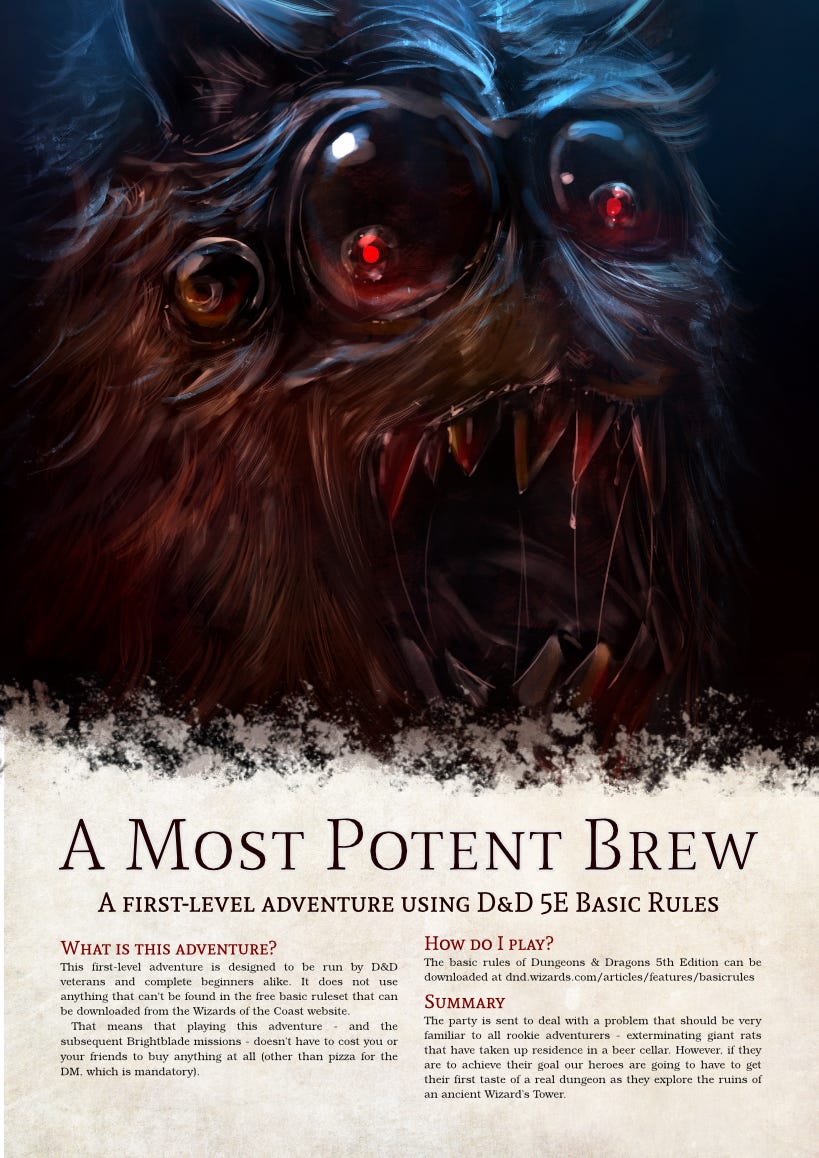And so it begins
First entry with reading notes about a "first adventure" module (we are getting meta already). I'm also getting into the dungeon23 challenge with my own twist on the formula.
INTRO
I’m still forming the newsletter concept as I’m writing this entry (isn’t that the beauty of language? Barely knowing what you’re going to say before actually doing so). I would like to use this part to talk about what I’m working on and extract some of my thought process. My guess is that I’ll keep updating it endlessly because the reflection on a feature sparkle new ways to improve it again and again…
… Interestingly enough, that’s not what happened. Instead, I expanded this intro into another full-fledged article about “Skills” that I decided to separate from this entry. Maybe I’m digging writing even more than I thought. As for this part, I start to wonder if I need it at all, I’ll leave this one for posterity.
READING NOTES
In that part I’m using one RPG, Module, bunch of Articles or even Podcasts as support to raise design questions and start answering them. What catches my interest will most likely be very subjective, so don’t take that as a review (Although, it will give insights on what it’s about, so it can help you form a decision I imagine)
And for the first entry we dive into…
A Most Potent Brew - A Basic Rules Adventure
A classic I heard, and indeed, this module has a lot of good traps that … how can I say … “caught” my attention.
The first one is about finding clues in a poetry and using them to move on a specific part of a mosaic floor to avoid being cut in halves. I'm not keen on enigma, so I overlooked it. What got me thinking instead are the following two encounters that "felt" like traps:
The slowly approaching fire spider makes for a great cinematic moment (triggered memories of Queen Gohma for the connoisseur) when you finally notice the glowing silhouette that has been lurking over you from the dark.
The rat, drinking the "enlargement" potion, becoming a (larger) threat after one minute if not taken care of.
The characteristics that separate traps and encounters can easily shift, making their definition look similar. The former could be in motion and even have a state bloc if you want to leverage the combat system or opposite checks. Likewise, the latter can feel like a static puzzle with a clear way to "disable" it and avoid the bad outcome.
Now, more than lexical consideration, those two encounters share a common flow:
You enter a space with several intriguing things and clues about a threat.
A timer starts without players knowing about it.
Depending on their actions, they'll have a more or less challenging outcome.
That sounds exactly what a trap design should be. You have several options, and you need to make the right one to avoid something undesirable. The first example was a static choice clearly telegraphed as an enigma; players don’t have any time constraint to process and think it through. Contrariwise, the other two are only hinted, and the puzzle becomes to figure out what's up before it's too late.
Last note on a different aspect, I also liked the simple tension arc of the module: From a friendly pub to a mysterious old space, to a dangerous dungeon, back to the safety of the starting point for a casual debrief. I had the same vibe reading through the Hobbit when, after all their adventure, Bilbo and Gandalf walk the way back home. We could call that a “diegetic closure”, and it may have a special place in TTRPG.
BIT SIZE REVIEWS
In this section I put 3 links with just enough context so you can get if it’s worth your time. Expect to find reviews, design breakdown or even content on adjacent topics for inspiration purposes.
It seems to be out of stock at the moment, but the picture still makes for great inspiration on a niche genre. You can follow the artist here or on Twitter.
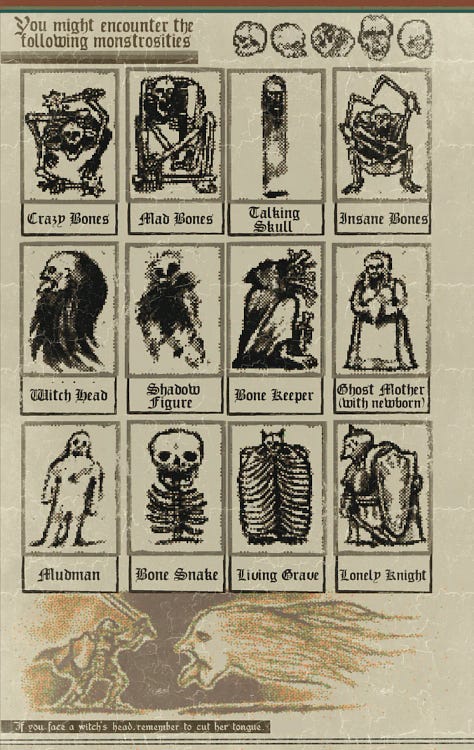
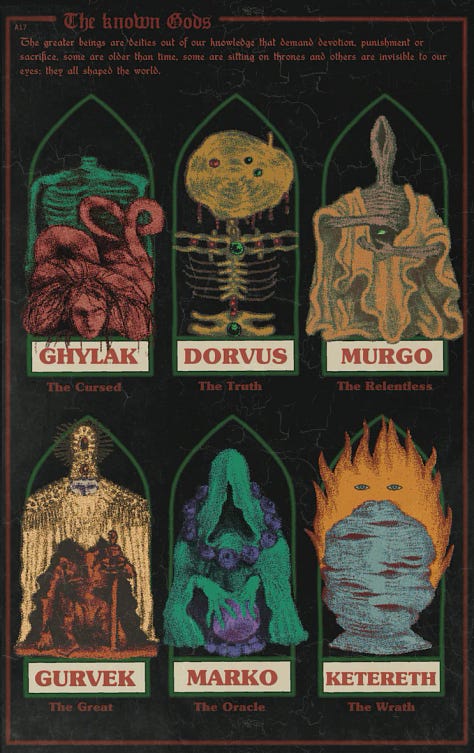
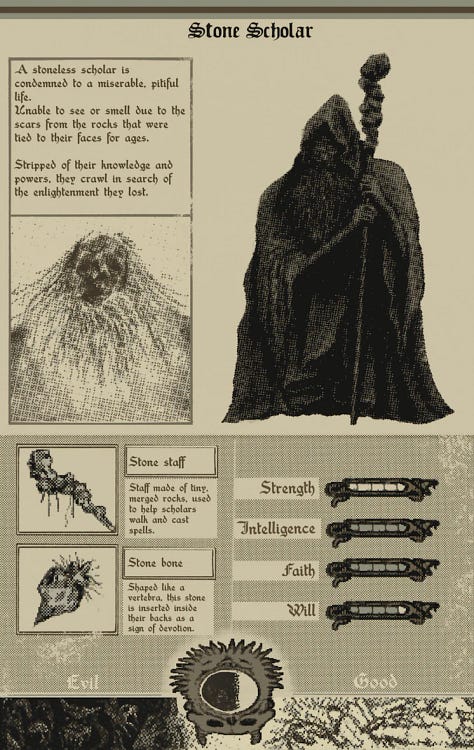
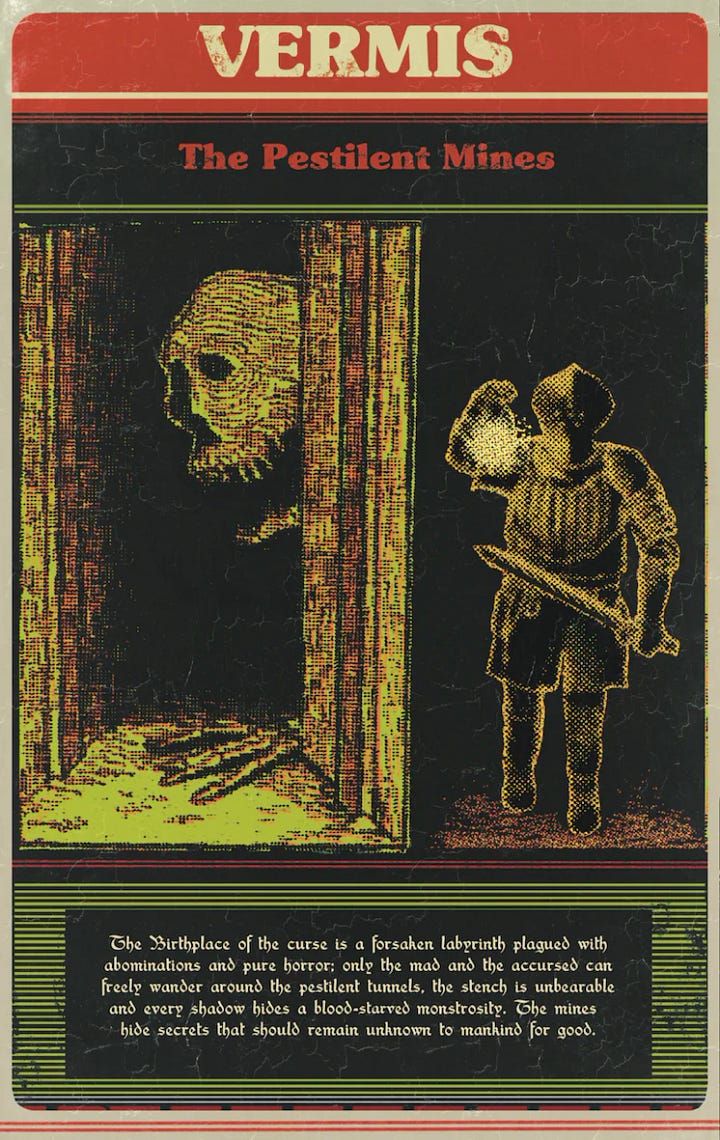
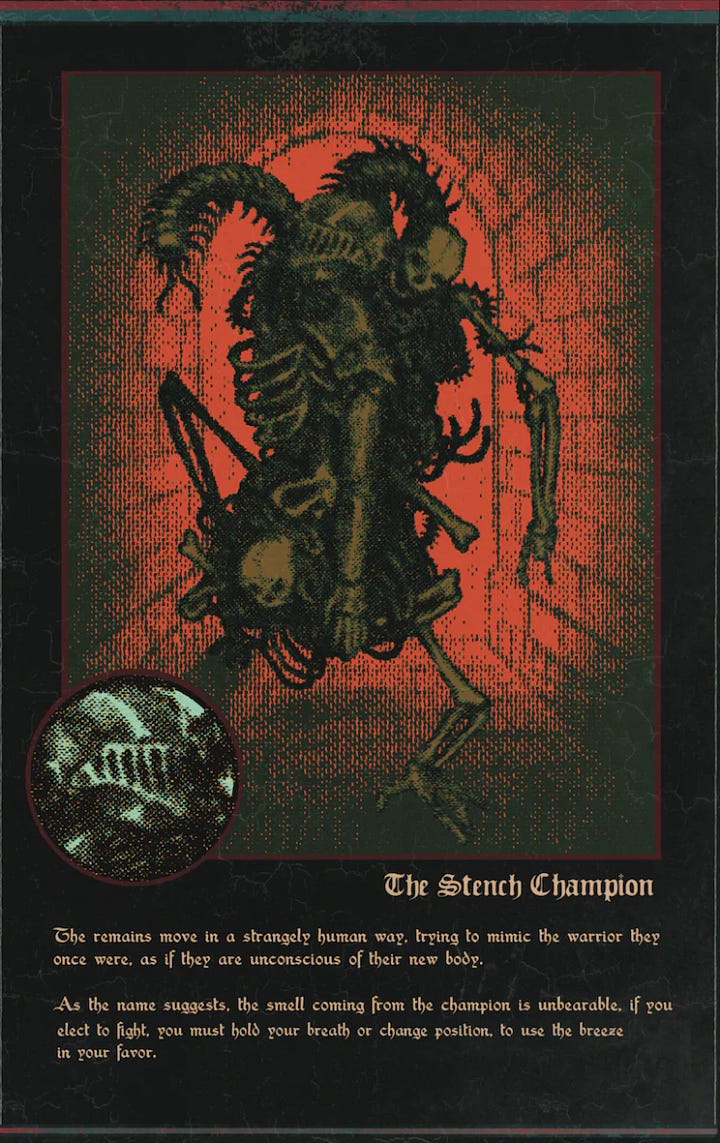
The whole conversation feels a bit disconnected (with good vibe nonetheless).
Provides insights on horror game design with some great pitches like: A (truly) giant beast that may smash you while wandering. Players may want to "get inside" it because it doesn't digest precious metal. You’re effectively taking the position of bacteria, competing with others at a completely different scale.
Not exactly mentioned like that, but there is an interesting correlation to be made between HP and “time on screen.” If a monster as a low amount of HP, it may not live long enough to develop complex skills over an encounter. On the contrary, you don't want a large pool of HP remaining if there is nothing fresh to showcase on the next round.
Great collection of topics that could each become the starting point for a full design conversation.
A ROOM
This section is dedicated to actually making something. We can talk and reflect and talk again about that reflection, sparking a new one that… Gathering knowledge; accumulating ideas; you also need to just DO. That being said, I still wanted a framework, a big picture in which all my small expressions would take a deeper meaning. Sean McCoy (main designer of Mothership) happens to give me a starting point … while, in the meantime, arguing that it isn't the way to go… Thanks anyway
In this post on Substack he began a trend that you can follow with the hashtag #dungeon23 on Twitter. The goal is to make a room per day during 2023 with the hope that it might make a full-fledged mega-dungeon down the line. The idea is appealing, but I still needed to:
Connect it fictionally to my RPG Bonaventure (not at all a dungeon crawler).
Get a basic understanding of the game flow I want…
… So I can define the key points that need to be described for each space.
I didn't fully answer those points, and I shouldn’t try to, because the goal is to make something first and foremost. Here’s my initial take anyway:
I’m playing with the idea of a spiritual world living side by side with the grounded, near future backdrop of Bonaventure.
This structure struck me as a perfect opportunity to make a Roguelike: small encapsulated bits of content arranged by a system to produce an interesting level in real time (Which I would translate with “at the table” in this instance).
In addition to environment and inhabitant description (namely rooms and monsters), I want to focus on its “connectivity” (dead end, fork, pathway, loop, going deeper) and potential “foreshadowing/after effect” (how does it affect other space when it comes online)
OK ... see how quickly this section gets filled with thoughts, “DO” we said; here it comes:
Room
Two golems in a room (6 m tall) both extremely strong, but equally built. They’re similar except one as a red glyph and looks one side while the other as a different mark painted in blue and faces the opposite direction. They’re chained together with narrow yet indestructible links. The chain is just folded two times around the central pole of a giant crank. It would be easy for them to coordinate and free themselves from it, but the titans are constructing their own self by opposition with the other. If one wants or say something, its counterpart readjust to focus on the contrary.
The room is high but narrow, making movement around in golems‘ reach. Each one will seek validation of the players as they pass by. If one is confronted, it will build anger and finally attack (grabbing and tearing apart). The other will try to defend the victim, although, in a limited capacity because it keeps facing the opposite direction.
Side Content
A massive door with engraved representation of an army of golems marching in unison against a “dark figure” (this figure could be replaced with any important character already defined). This door is open if you find a way to turn the crank in the room.
Deep voice arguing over a topic; tinkling of a chain.


